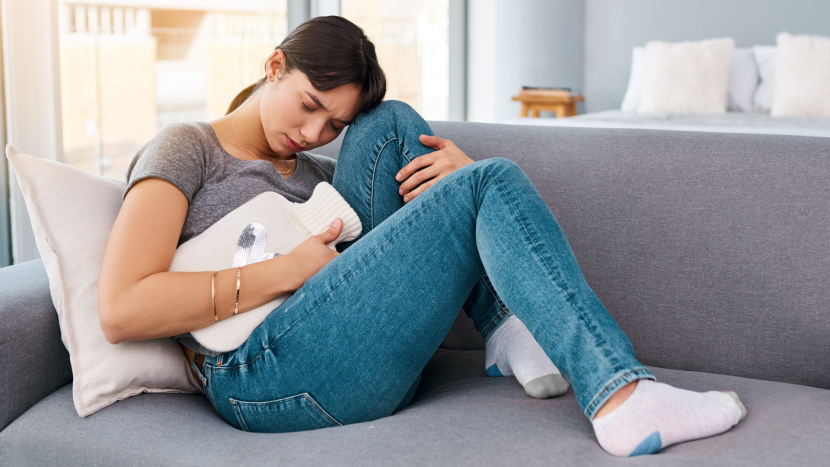Polycystic Ovary Syndrome (PCOS) is a common hormonal disorder affecting 6–13% of reproductive-aged women worldwide. Despite its prevalence, around 70% of women with PCOS remain undiagnosed, often struggling with symptoms without knowing the underlying cause. This condition is characterized by irregular menstrual cycles, excess androgen levels, and the formation of small cysts on the ovaries. It can lead to complications such as weight gain, insulin resistance, infertility, and an increased risk of diabetes and heart disease.
Managing PCOS requires a holistic approach, and yoga has proven to be an effective natural remedy. Regular yoga practice helps regulate hormones, improve insulin sensitivity, and promote better reproductive health. Additionally, yoga reduces stress levels, which is crucial since stress can worsen PCOS symptoms. By incorporating yoga into daily life, women with PCOS can achieve better hormonal balance, improved mental well-being, and overall enhanced quality of life.
How Yoga Helps in Reducing PCOS
Yoga is a powerful, natural way to manage Polycystic Ovary Syndrome (PCOS) by addressing its root causes, such as hormonal imbalances, insulin resistance, and stress. Regular practice of yoga promotes overall well-being.
- Balances Hormones: Yoga stimulates the endocrine glands, including the ovaries and thyroid, helping to regulate hormone production. This can reduce excess androgens, improve insulin sensitivity, and promote regular menstrual cycles.
- Improves Insulin Sensitivity: Many women with PCOS experience insulin resistance, which can lead to weight gain and increased blood sugar levels. Yoga enhances insulin sensitivity, helping the body use glucose efficiently, reducing the risk of diabetes.
- Aids in Weight Management: Women with PCOS often struggle with weight gain due to insulin resistance. Yoga, combined with mindful breathing, boosts metabolism, improves digestion, and aids in fat loss, making it easier to maintain a healthy weight.
- Enhances Reproductive Health: Regular yoga practice reduces inflammation, promotes ovulation, and strengthens the uterus, increasing the chances of conception for women with PCOS who are trying to conceive.
- Reduces Stress: Stress is a major contributor to hormonal imbalance in PCOS. Yoga activates the parasympathetic nervous system, lowering cortisol (stress hormone) levels. This helps in reducing anxiety, mood swings, and emotional distress linked to PCOS.
Top 5 Yoga Poses for Reducing PCOS: Steps & Benefits
- Butterfly Pose (Baddha Konasana)

- How to Pose: Sit on the floor with your legs extended in front of you. Bring your feet together and allow your knees to fall open to the sides. Hold your feet with your hands and gently press your knees toward the floor. Keep your spine straight, and breathe deeply.
- Benefits: Butterfly Pose increases blood flow to the pelvic region, which helps regulate ovarian function and reduces ovarian cyst formation. It also stretches the inner thighs and groin, releasing tension and improving flexibility. This pose is effective for maintaining regular menstrual cycles and improving overall reproductive health.
02. Cobra Pose (Bhujangasana)

- How to Pose: Lie on your stomach with your legs extended and the tops of your feet flat on the floor. Place your hands on the ground under your shoulders with your elbows bent. Slowly lift your chest off the ground by straightening your arms, arching your back, and keeping your elbows slightly bent. Look forward and hold the position for a few breaths.
- Benefits: Cobra Pose stimulates the ovaries and reproductive organs, helping balance hormones related to PCOS. This pose improves digestion, boosts metabolism, and alleviates symptoms such as bloating and stress. It also opens up the chest, encouraging deeper breathing and reducing tension, making it a great stress reliever.
03. Cat-Cow Pose (Marjaryasana-Bitilasana)

- How to Pose: Start on your hands and knees with your wrists directly under your shoulders and knees under your hips. Inhale as you arch your back (Cow Pose), lifting your tailbone and chest, and exhale as you round your back (Cat Pose), tucking your chin toward your chest and drawing your belly button toward your spine. Repeat for several rounds.
- Benefits: This dynamic flow helps massage and tone the abdominal organs, improving digestion and promoting better hormonal balance. The movement encourages spinal flexibility and relieves lower back tension, which is beneficial for women with PCOS who may experience discomfort. The fluid movement between Cat and Cow poses also reduces stress and enhances emotional well-being.
04. Garland Pose (Malasana)

- How to Pose: Stand with your feet slightly wider than hip-width apart and squat down as deeply as comfortable. Keep your heels grounded and press your elbows against your inner thighs. Bring your palms together in a prayer position in front of your chest. Ensure your spine is long and straight while breathing deeply.
- Benefits: Garland Pose opens the hips, increases circulation to the pelvic region, and helps strengthen the reproductive organs. This pose stimulates the digestive system, promotes better metabolism, and relieves tension in the lower back and hips. Regular practice helps alleviate bloating and improves hormonal balance, making it particularly effective for PCOS.
05. Bridge Pose (Setu Bandhasana)

- How to Pose: Lie on your back with your knees bent and feet flat on the floor, hip-width apart. Place your arms alongside your body with palms facing down. As you inhale, lift your hips toward the ceiling, pressing your feet firmly into the ground. Keep your thighs parallel and avoid letting your knees splay out. Hold for a few breaths and slowly lower your hips.
- Benefits: Bridge Pose helps open the chest and stimulates the thyroid gland, promoting hormonal balance and reducing stress. It strengthens the lower body, especially the glutes, hamstrings, and lower back, while improving blood circulation to the reproductive organs. This pose is especially beneficial for women with PCOS as it helps relieve symptoms of fatigue, stress, and poor circulation.




